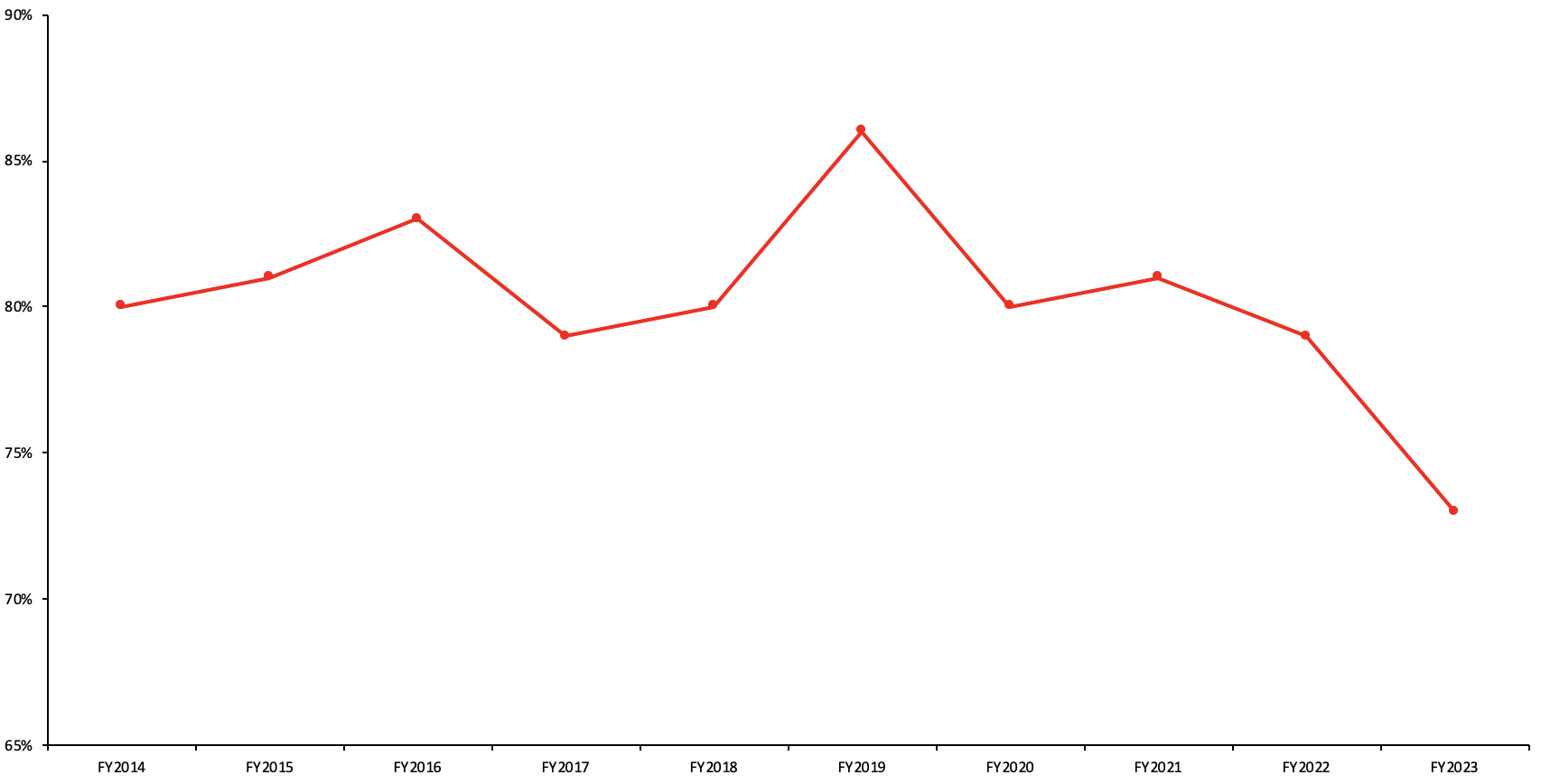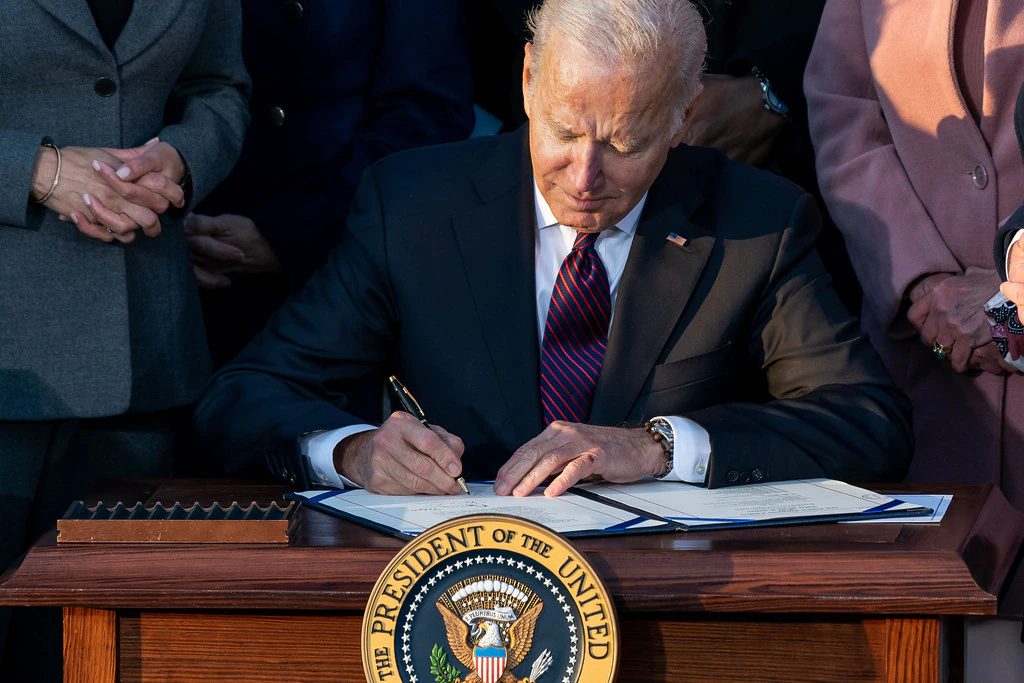‘Got-Away’ Tsunami Is the Best Measure of the Decline in Border Security Under Biden
Critics of the administration’s immigration policies have largely focused on DHS Secretary Alejandro Mayorkas’ failure “to achieve and maintain operational control” of the Southwest border, a 16-year-old statutory mandate. Not that they’re wrong, but they’re missing two much more telling border-control metrics also enshrined in statute: the “got-away” rate, which has exploded ever since Biden took office; and the “unlawful border crossing effectiveness rate”, a measure of CBP’s effectiveness in securing the border, which has increasingly declined even as the Biden administration assures Americans that it has the border well in hand. The president’s policies and his DHS secretary’s performance are increasingly degrading U.S. border security and endangering us all — and we have the numbers to prove it.
Biden’s Border Record. By any reasonable standard, the Southwest border was in pretty good shape when President Biden took office. As Biden’s first Border Patrol Chief, Rodney Scott, described the situation in a September 2021 letter to Senate leadership, the prior administration bequeathed the current occupant of the Oval Office “what was arguably the most effective border security in” U.S. history.
Things went downhill quickly, according to Scott, as “Common sense border security recommendations from experienced career professionals [were] ignored and stymied by inexperienced political employees”.
Those “inexperienced political employees” Scott referenced were likely taking their orders from the top, as Biden quickly rescinded nearly all the policies his predecessor had implemented to deter illegal migration at the U.S.-Mexico line, most prominently the “Migrant Protection Protocols” (MPP), better known as “Remain in Mexico”.
Briefly, section 235(b) of the Immigration and Nationality Act (INA) requires DHS to detain all “applicants for admission” — including illegal entrants — deemed inadmissible by Border Patrol agents and CBP officers at the nation’s borders.
As a Supreme Court filing by Biden’s own DOJ reveals, both the Obama and Trump administration largely complied with that statutory detention mandate. Some 91 percent of all aliens encountered by CBP at the Southwest border in FY 2013 were detained in whole or part throughout their removal proceedings, as were 83 percent as recently as FY 2018.
The demographics of illegal entrants shifted quickly in FY 2019, when more than 55 percent of migrants apprehended entering illegally at the Southwest border were adult migrants travelling with children in “family units” (FMUs).
Under a poorly reasoned 2015 district court order, DHS may only detain the children in FMUs for 20 days, and to avoid “family separation”, the adults are usually released within that time frame as well.
So many family migrants entered in FY 2019 that agents simply released most of them right away (just 59 percent of aliens encountered that year were detained in whole or part). That, a bipartisan federal panel convened to study FMU entries explained in an April 2019 report, simply encouraged more to enter illegally.
Unable to detain those FMU migrants, and seeking to stem the surge, the Trump administration created Remain in Mexico. Aliens subject to MPP were sent back to Mexico — where the Mexican government agreed to provide for them — to await their removal hearings, and in an October 2019 assessment, DHS deemed the program “an indispensable tool in addressing the ongoing crisis at the southern border and restoring integrity to the immigration system”.
Biden railed against Remain in Mexico on the campaign trail, however, and his administration has been fighting in the federal courts for more than two years (thus far successfully) to end the program entirely. In any event, no alien has been sent back to Mexico under MPP since last August.
Despite ending MPP, President Biden has repeatedly requested that Congress cut funding to detain illegal entrants, and his administration has almost universally opted to ignore the section 235(b) detention mandate.
Just 36 percent of all aliens encountered at the Southwest border in FY 2021 were detained in whole or part (compared to 79 percent in FY 2020), while 90 percent were either never detained or released (compared to 34 percent the prior fiscal year).
Border Patrol Staffing vs. Apprehensions. As the likelihood that illegal entrants, even if they were caught, would be allowed into the United States has soared, the number of aliens apprehended entering illegally at the Southwest border has skyrocketed, from just over 400,000 in FY 2020 to nearly 1.66 million in FY 2021.
Border Patrol set a record for apprehensions in FY 2022 (more than 2.2 million), and in just the first eight months of FY 2023, agents have already caught more than 1.4 million aliens who entered illegally at the U.S.-Mexico boundary.
The biggest problem from an operational standpoint is that the Biden administration has steadfastly refused to ask Congress for sufficient Border Patrol resources to handle the flow. The number of agents at the Southwest border actually fell from a high of 18,610 in FY 2013 to fewer than 17,000 in FY 2020.
While Mayorkas has scrambled to redeploy agents from other duties of late (he claimed in May there were “24,000 Border Patrol agents and officers” on the Mexican border, but that blurs the distinctions between the ports and the border between them), that has left the Northern border, in particular, increasingly vulnerable.
What agents there are at the Southwest border have been increasingly taxed by that migrant surge. Nearly all the aliens apprehended there have been “give-ups”, that is, migrants who have crossed the border illegally and waited for agents to pick them up in the (reasonable) expectation that they will be released.
Agents must still round up, transport, process, and care for those give-ups, which has left them increasingly unable to stop other migrants who don’t want to be caught, as well as illicit drugs and other contraband. I will return to that point below but suffice it to say that agent morale has been at its lowest point in history for more than two years.
“Operational Control” and the Secure Fence Act of 2006. As noted, critics of this disaster have largely focused on the statutory “operational control” mandate, which was included in the Secure Fence Act (SFA) — a bill passed in 2006 with broad bipartisan support, including the assent of then Sens. Barack Obama (D-Ill.), Hillary Clinton (D-N.Y.), and Joe Biden (D-Del.).
Section 2(a) of the SFA requires the DHS secretary to “take all actions [he] determines necessary and appropriate to achieve and maintain operational control over the entire international land and maritime borders of the United States”.
Lest there be any doubt about Congress’ intent, it defined “operational control” as “the prevention of all unlawful entries into the United States, including entries by terrorists, other unlawful aliens, instruments of terrorism, narcotics, and other contraband”.
In a recent post, I explained that through the end of May, Biden’s DHS has released — at a minimum, and on the extremely low side — 2,184,124 illegal aliens at the Southwest border, “a population larger than Dallas and San Francisco combined, or about 70,000 more people than live in New Mexico, the 36th largest U.S. state”. Thus, Mayorkas has plainly failed to meet the SFA standard.
When confronted with this, the secretary has attempted to redefine “operational control”, complaining that it is an impossible standard to meet, but both Mayorkas and his congressional foes miss a key point — “operational control” is plainly the goal in the SFA, but the standard is whether Mayorkas is “taking all actions necessary and appropriate” to achieve that goal.
He’s not, both because he has failed to staff the Southwest border adequately and — importantly — he has failed to spend $2.75 billion in congressional funding allocated for border barriers and infrastructure. Biden put a freeze on that cash his first day in office, and since then DHS has spent just a fraction of it.
Why do I say “importantly”? Because it’s the “Secure Fence Act” for a reason. Congress has concluded that fences and other infrastructure are critical to border security. Mayorkas has never even attempted to rebut that conclusion (not that it would matter in this context, because Congress makes the rules), and his failure to secure the border with already paid-for infrastructure is a clear abrogation of his duties.
Section 1092 of NDAA 2017. While it’s obvious that Biden’s DHS secretary has failed to comply with the operational control standard in the SFA, Congress is overlooking two much more important metrics for assessing the state of border security and the degree to which both the president and Mayorkas have allowed the border to slide into chaos.
Included in the National Defense Authorization Act for Fiscal Year 2017 (NDAA 2017) was a section 1092, “Border Security Metrics”, which is now codified at 6 U.S.C. §223. Section 1092 requires the DHS secretary to “develop metrics, informed by situational awareness, to measure the effectiveness of security between ports of entry”, and to provide an annual report on the results to the GAO, and to the Senate Homeland Security and Governmental Affairs and House Homeland Security Committees.
One of those metrics is the annual number of “got-aways”, defined in section 1092(a)(3) of NDAA 2017 as: “an unlawful border crosser who- (A) is directly or indirectly observed making an unlawful entry into the United States; (B) is not apprehended; and (C) is not a turn back”. “Turn-backs” are illegal entrants whom agents have scared away, who have fled back across the border.
The last such report, for FY 2021, was filed with GAO and the committees in May 2022, but it only includes “got-away” statistics from FY 2010 through the end of FY 2020.
It reveals that during that 11-year period, got-ways peaked in FY 2013 (171,633), and remained roughly static just north of 101,000 between FY 2015 and FY 2017 before jumping again in FY 2018 (128,679) and FY 2019 (151,466), then dipping again in FY 2020 (136,808), roughly coinciding with MPP and Title 42.
Again, those are the last published got away numbers, but Mayorkas told the House Judiciary Committee in April 2022 that there were 389,515 got aways in FY 2021, while Fox News reported in October that there were 599,000 got aways in FY 2022. At an early May White House press conference, Mayorkas was asked about reports that there had already been more than 530,000 gotaways in FY 2023 (“roughly the size of the population of the city of Baltimore”), which he did not deny.
That’s more than 1.5 million aliens who entered illegally and are now living in the United States, largely if not completely free from any official constraint — “roughly the size of the population of Philadelphia”, America’s sixth-largest city.
Here’s how that looks, when graphed:
Got-Aways, by Fiscal Year |
 |
If you are looking for one chart that reveals how drastically DHS’s ability to secure the Southwest border has been degraded under the Biden administration, look no further, and what’s more, it comes with Congress’ imprimatur. And, if you want to see what it looks like on the ground, check out this video by my colleague Todd Bensman.
The “Unlawful Border Crossing Effectiveness Rate”. Section 1092(b)(1)(C) of NDAA 2017 also directs DHS to create a calculus for the “unlawful border crossing effectiveness rate”, that is, the total of apprehensions, turn-backs, and Title 42 expulsions divided by that same figure plus got-aways — essentially a metric that measures the effectiveness of CBP’s apprehension and deterrence efforts and administration policies.
Again, the most recent report only includes data through the end of FY 2020, so I will omit the turn-back numbers for FY 2021 through FY 2023. That should not make much of a difference, as the number of turn-backs is reflected in both the numerator and the denominator. Here’s what that looks like, when graphed:
Unlawful Border Crossing Effectiveness Rate, by Fiscal Year and Percentage |
 |
As noted, I am working with imperfect data, and missing a key statistic (“turn-backs”), but regardless, that chart reveals two things: (1) the effectiveness of Remain in Mexico and Trump’s other border policies in securing the border, particularly in FY 2019; and (2) how ineffective, despite its recent claims — and by Congress’ own metrics — Biden’s policies in the past three years have been in securing the border.
Why It Matters. The fact that these metrics were included in and mandated by the “National Defense Authorization Act” should not be overlooked. Note that the sponsor of that bill was the late Sen. John McCain (R-Ariz.) — a man who knew a great deal about both national security and border security. He understood, as did most of the members of the 114th Congress, how critical it was to our nation’s security to know who was coming into the country.
I recently explained that those lessons have been largely forgotten by both the Biden administration and by many in the current, 118th Congress. From personal experience, I can assure you that Sen. McCain (no shrinking violet) was an active figure in the post-September 11th legislation passed to protect this nation and its institutions.
Given that the Biden administration has been effectively rubber-stamping migrant releases from custody, ask yourself what sort of illegal migrants don’t want to be caught? Likely a lot of single adult males who are not expecting many breaks, to be sure, but also serious criminals (especially those with prior records here), and would-be terrorists.
In the first eight months of FY 2023 alone, Border Patrol agents have already apprehended 125 illegal aliens on the terrorist watchlist at the Southwest border — a 27.5 percent increase over FY 2019 (98), a 733 percent increase over FY 2021 (15), and more than 41 times as many as in FY 2020 (3). I would include FY 2019, but no terrorist watchlist aliens were apprehended by Border Patrol that fiscal year.
Not to be an alarmist, but there’s no way that CBP’s “unlawful border crossing effectiveness rate” has fallen from 86 percent in FY 2019 to less than 73 percent in FY 2023, and yet increasingly overworked agents have somehow gotten exponentially better at identifying and stopping all the aliens who are known or suspected terrorists.
Bringing It All Together. Don’t think that I am criticizing the various members of Congress who have been focused on the DHS secretary’s failure to comply with the operational control mandate in the SFA. Last April, I called it the “most important border law”, and I stand by that statement.
To be fair to Secretary Mayorkas, it is a challenging standard to meet, however. Perhaps his performance in achieving it should be measured by the effectiveness of his predecessors. Which is where section 1029 of NDAA 2017 comes in.
No one can say that the metrics required therein are somehow random, inaccurate, or unfair. It was passed by a Republican-controlled Congress, to be sure, but it was signed by Biden’s old boss, President Obama.
Tying together the “operational control” mandate in the Secure Fence Act, and the “border security metrics” in the National Defense Authorization Act for Fiscal Year 2017, two things are clear: (1) not only is Mayorkas failing to comply with Congress’ standards; but (2) the secretary’s performance and the president’s policies are increasingly degrading security at the Southwest border and endangering us all.






